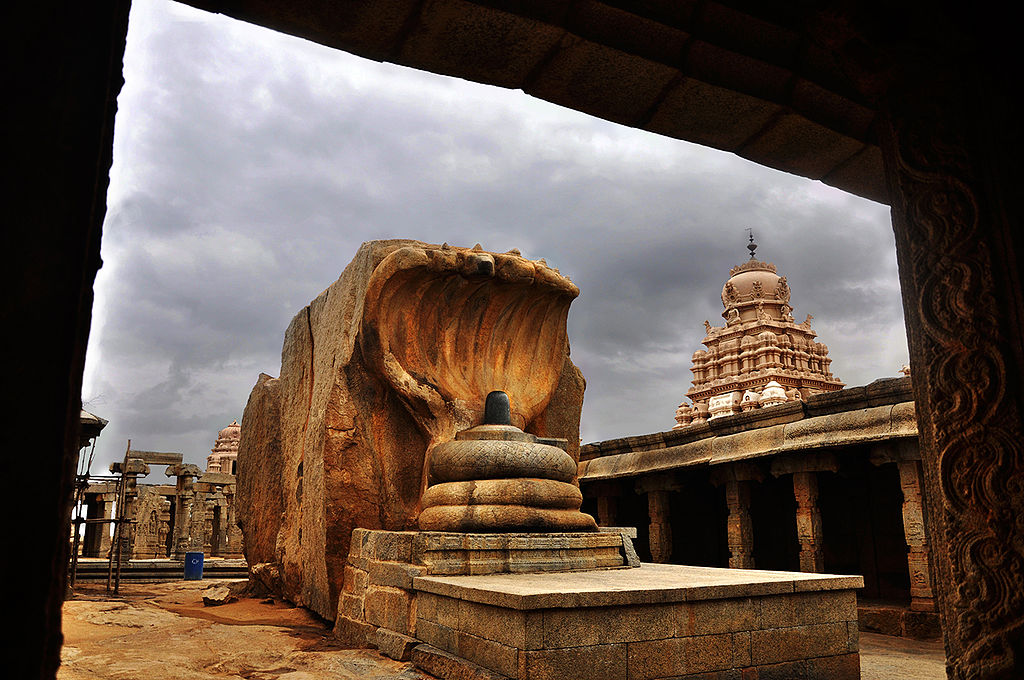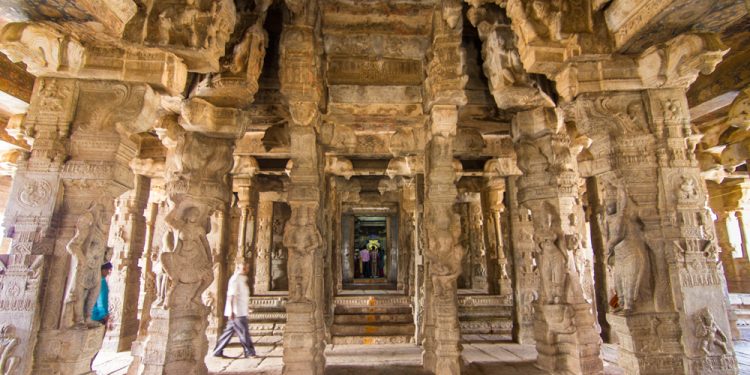The Veerabhadra temple is in Lepakshi in the Anantapur district of the Indian state of Andhra Pradesh. Built in the 16th century, the architectural features of the temple are in the Vijayanagara style with a profusion of carvings and paintings on almost every exposed surface of the temple.
Shrine’s History
The temple was built in 1530 by Virupanna Nayaka and Viranna, both brothers who were Governors under the Vijayanagar Empire during the reign of King Achutaraya, at Penukonda. The cost of building the temple was defrayed by the government. According to Skanda Purana, the temple is one of the divyakshetras, an important pilgrimage site of Lord Shiva.

Architectural Relevance of This Shrine
The temple is of the Vijayanagara architectural style.The main temple is laid out in three parts, these are: The assembly hall known as the Mukha mantapa or Natya mantapa or Ranga mantapa; arda mantapa or antarala and the garbhagriha or the sanctum sanctorum. The temple, as an edifice, is encircled by two enclosures. The outermost walled enclosure has three gates, the northern gate is used regularly. The inner east gate is the entry to the assembly hall, which is a large sized open hall designed with a large space in its central part.It is at the entrance to the sanctum sanctorum and has a profusion of sculptures and paintings over every inch of space on the columns and ceiling.The images on the pillars and walls are of divine beings, saints, guardians, musicians, dancers and 14 avatars of Shiva. Figurines of the goddesses Ganga and Yamuna flank the entrance to the sanctum.
The exterior columns of this hall are built over a decorated plinth; the decorations are in the form of blocks of carved images of horses and soldiers. The columns are slim and have features of collonettes carved with eaves, overhanging in a curved shape. The open space in the middle part of the hall is defined by large columns or piers which have carvings of triple figures.In the columns in the northeastern part of the hall, there are images of Natesha flanked by Brahma and a drummer. In an adjoining column there are figurines of nymphs in dancing postures, flanked by a drummer and cymbalist. The column at the southwest part of the hall has an image of Parvathi, Shiva’s consort, flanked by female attendants.
There are also carvings of divinities such as Bhringi with three legs and Bhikshatana carved in a dancing posture; this is in the northwestern part of the hall. The ceiling of the hall is fully covered with mural paintings depicting the scenes from the epics, the Mahabharata, the Ramayana, and the Puranas along with the life sketches of the benefactors of the temple.The paintings in each bay on the ceiling of the main mandapa, the antarala and other shrines, depict the grandeur of Vijayanagara pictorial art. They are painted over an initial plaster layer of lime mortar. The colour scheme consists of vegetable and mineral colours of yellow, ochre, black, blue and green blended with lime water; the background is generally painted in red colour.
Apart from figures of gods and goddesses, in the presence of the devotees arranged in rows, the frescoes also depict the incarnations of Vishnu..The paintings are in striking compositions where the particular emphasis is on the period costumes and facial expressions. The fresco in the ceiling of ardha mantapa, which is said to be Asia’s largest, measures 23 by 13 feet. It has frescoes of the 14 avatars of Lord Shiva as: Yogadakshinamurthy, Chandes Anugraha Murthy, Bhikshatana, Harihara, Ardhanarishwara, Kalyanasundara, Tripurantaka, Nataraja, Gouriprasadaka, Lingodhbava, Andhakasurasmahara and so forth.
The presiding deity deified in the sanctum sanctorum is a near life-size image of Veerabhadra, fully armed and decorated with skulls. There is a cave chamber in the sanctum where sage Agasthya is said to have lived when he installed the image of the Linga here. The ceiling in the sanctum above the deity has paintings of the builders of the temple, Virupanna and Viranna, regally dressed and crowned with headgear similar to those adorning the Krishnadevaraya’s bronze statue in Tirupati. They are depicted, with their entourage, in a state of reverential prayer, being offered sacred ashes of their family deity. Within the temple complex, on the eastern wing, there is a separate chamber with Shiva and his consort Parvathi carved on a boulder. In another shrine chamber there is an image of Lord Vishnu.
Within the temple precincts, to its eastern side, there is a huge boulder of granite stone which has the carving of coiled multi-hooded serpent providing an umbrella cover over a Linga. A huge granite Nandi, 20 feet in height and 30 feet in length, bedecked with garlands and bells, carved out of a single block stone, is located about 200 metres from the temple, which faces the statue of the serpent in the precincts of the temple
Shrine’s Map Location and How to Go There
By Road
Hindupur is a major town nearby and 14 km away from Lepakshi. One can reach Lepakshi through Hindupur. There are lots of private bus services and APSRTC buses connecting Hindupur and Lepakshi for every 10 minutes. One who is travelling in a car from Bengaluru can also reach Lepakshi without touching Hindupur and through NH 44.
By Rail
Hindupur railway station is a major railway station nearby and it is well connected to Bengaluru and Anantapur – couple of passenger and express trains run daily to and from
By Air
Kempegowda International Airport is the nearest one and 101 km away from Lepakshi via NH 44.
Events Celebrated at This Shrine
During 10 day festival in the month of Feb, Ratham (car) festival attracts thousands of devotees from nearby places.













































